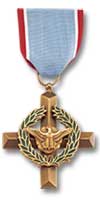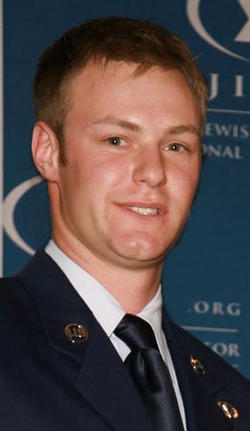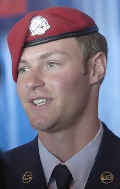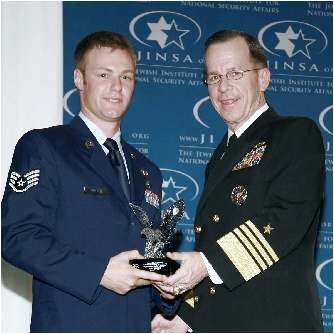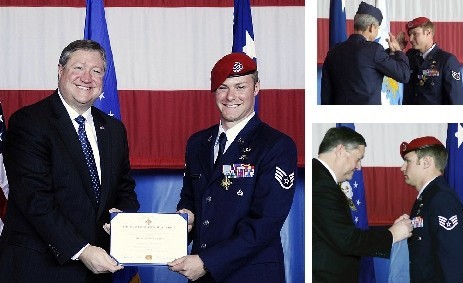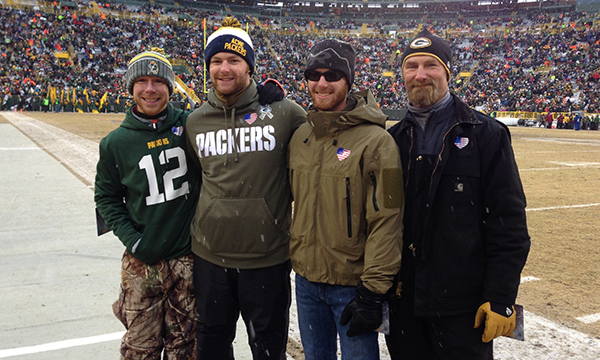Combat Controller
Zachary Rhyner is awarded the Air Force Cross..... sent by Wayne Norrad, Johnny
Pantages, & Joe Edwards
During the first 15 minutes, Rhyner was wounded along with three team
members.
“I was pulling security when I got shot in the leg,” he said. “The rounds hit my left thigh and went through my leg and hit another guy in the foot.” Rhyner remembered the pain and adrenalin. “There was nowhere to go. I grabbed the wounded guys, but we were trapped by the enemy,” he said. “I was calling in air strikes and firing, while moving the wounded down [the cliff].” By the end of the battle, Rhyner had called in a total of 4,570 rounds of cannon fire, nine Hellfire missiles, 162 rockets, a dozen 500-pound bombs and one 2,000-pound bomb, while firing his M-4 rifle to protect his team. “If it wasn't for Zach, I wouldn't be here,” Gutierrez said. Rhyner will be the third airman to earn the Air Force Cross since 2001. He will receive the medal March 10 at the Pentagon, an Air Force spokesman said. The two other airmen to earn
the Air Force Cross in recent years were awarded the medal
posthumously: Senior
Airman Jason D. Cunningham, a pararescueman, and Tech.
Sgt. John Chapman, a Combat Controller, who both died in 2002
during the Battle for Roberts Ridge, part of Operation Anaconda. 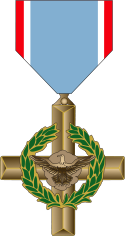
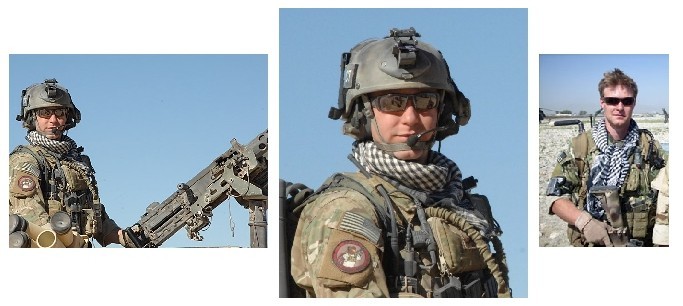

Fayetteville Observer; A Pope Air Force Base Combat Controller is scheduled to receive the Air Force’s second highest award for valor on March 10 in a ceremony at the Pentagon. Staff Sgt. Zachary J. Rhyner will receive the Air Force Cross for his actions on April 6 in the Shok Valley in Afghanistan. Although shot in the left leg, he called in airstrikes, fired his M-4 rifle at the enemy and helped move other wounded people down a cliff. Rhyner is assigned to the Air Force Special Operations Command’s 21st Special Tactics Squadron at Pope. At the time of the incident, Rhyner was a senior airman who had completed training less than a year earlier. Combat Controllers train for two years at Pope and elsewhere to do mostly covert missions in hostile territory. The “battlefield airmen” can parachute or infiltrate into enemy territory to set up drop zones, do air-traffic control or call in aircraft to shoot or drop bombs on the enemy. They often work on an Army Special Forces or Navy SEAL team and fight alongside soldiers and sailors while summoning Air Force firepower from overhead. The aircraft often are firing near “friendly” forces on the ground. Rhyner
is credited with saving his team from being overrun twice in a 6-hour
battle in the Shok Valley. Members of A-Team 3336 from Fort
Bragg’s 3rd Special Forces Group received 10 Silver Stars,
the Army’s third highest award for combat valor, for their
actions in that engagement.
About 100 Special Forces and Afghan soldiers each were carrying more than 60 pounds of equipment when they jumped from helicopters onto icy, jagged rocks and waist-deep running water in 30-degree temperatures to assault a terrorist stronghold in Afghanistan. Their objective was at the top of the mountains surrounding the valley. They
were ambushed by 200 enemy fighters, and Rhyner was shot within the
first 15 minutes, according to an account from the Air Force Special
Operations Command. The team came under fire from all directions from
snipers, machine guns and rocket-propelled grenades.
Shok
Valley is located below 60-foot cliffs. The mission objective was at
the top of the mountains surrounding the valley.
"Initial infiltration began that day with snow on the ground, jagged rocks, a fast-moving river and a cliff," Sergeant Rhyner said. "There was a 5-foot wall you had to pull yourself up. The ridgeline trail was out of control."
The expectation was to encounter fire from about 70 insurgents. One Air
Force JTAC-qualified Combat Controller was attached to each team to
call in airstrikes, if needed.
"We were caught off guard as 200 enemy fighters approached," said Staff Sgt. Rob Gutierrez, a Combat Controller with the second team in the fight. "Within 10 minutes, we were ambushed with heavy fire from 50 meters. The teams were split by a river 100 to 200 meters apart, north to south." Sergeant Rhyner was in charge of coordinating the air assets. "I have never seen a situation this bad," said Captain Parker, who was monitoring the situation back at the base. "The intel said the enemy was 40 feet away from Zach and his team at one point. It was dangerous." Within the first 15 minutes of fire, Sergeant Rhyner was wounded along with three team members. "I was pulling security when I got shot in the leg," he said. "The rounds hit my left thigh and went through my leg and hit another guy in the foot." Sergeant Rhyner said he immediately felt pain and adrenalin. "There was nowhere to go. I grabbed the wounded guys, but we were trapped by the enemy," he said. "I was calling in airstrikes and firing, while moving the wounded down (the cliff)." Sergeant Gutierrez said he could see insurgent fire coming from the buildings on the hilltops above them and was trying to get across the river to meet up with Sergeant Rhyner. "Zach and I were in constant radio contact," he said. "I could hear the ammunition, sniper fire and rocket-propelled grenades with multiple blasts. We tried to push to the north to collocate with Zach's team, but every time we pushed up river, it put us in an open line of fire." "My team ran across the freezing river. The water came off the mountains, and we were 100 to 200 feet beneath the enemy, like fish in a barrel," Sergeant Gutierrez said. As the enemy surrounded them, Sergeant Rhyner, who was being treated for his injuries by Capt. Kyle Walton, the special forces team leader, directed multiple rockets and gun runs from AH-64 Apache helicopters against enemy positions. "Zach was coordinating tremendous amounts of fire on both villages simultaneously," Sergeant Gutierrez said. "Zach was in charge of the airstrikes, since he was closest to the fight and could see even what the F-15 (Eagle) pilots could not." Forty-five minutes to an hour had gone by since the fight began. "We were pinned down and I could see the enemy all over the hills running around," Sergeant Gutierrez said. There were no stable targets. I kept the Apaches and the Hellfire missiles pressed to the north." Accurate sniper, machine gun and RPG fire poured down on the assault force in a complex ambush initiated simultaneously from all directions as Alpha Team 3336 ascended the near-vertical terrain. He called in more than 50 close airstrikes and strafing runs. Three hours into the fight, Sergeant Gutierrez reached Sergeant Rhyner's position. "Sergeant Gutierrez and I met on the cliff during the battle briefly. We shared a laugh, but it was a busy, bleak situation," Sergeant Rhyner said. Sergeant Rhyner had been calling in airstrikes for three hours while he was injured; however, he still felt responsible for the others who had been hurt. With disregard for his own life, he tried to get the injured to safety, still in the open line of fire. "I left injured personnel in a house and I had to get over there," he said. "I was frustrated being wounded. I tried to get the bombs there fast and talk to the pilots who didn't see what I saw on the ground." Five or six hours into the fight, as it was getting dark, intelligence informed the JTACs that enemy reinforcements were 10 kilometers away carrying enemy rockets and missiles. "We continued to fight our way up the hill and the (helicopters) came," Sergeant Gutierrez said. "Zach was talking to the helos and gave the coordinates to lay the bombs on the village, while I kept the A-10 (Thunderbolt IIs) and the Apaches out of the way." Sergeant Rhyner called in a total of 4,570 rounds of cannon fire, nine Hellfire missiles, 162 rockets, 12 500-pound bombs and one 2,000-pound bomb, constantly engaging the enemy with his M-4 rifle to deter their advance. "Zach acted fast and shut down the fighting," Sergeant Gutierrez said. "The wounded were taken out on medevac." Back at command and control, Captain Parker heard that the helicopters were on the ground with the wounded but he could not move the helicopters due to the terrain and weather conditions. "Radio transmissions would block the signal due to terrain and vertical cliffs," he said. "Helicopters were vulnerable and there was pressure to do everything we could to get the teams out quickly." Fog then started rolling into the valley. "At 8,000 feet, the helicopter couldn't fly (due to altitude) and the situation called for 'aggressive patience,'" Captain Parker said. "More than 50 percent of the U.S. forces were wounded, and it was pretty grave." Toward the end of the fighting, 40 insurgents were killed and 100 wounded Sergeant Rhyner was directly credited with the entire team's survival due to his skill and poise under intense fire. "Sergeant Rhyner is out of training less than a year and is in one of the most difficult situations," Captain Parker said. "It is an absolute testament to his character and the training these guys take. It tells me we are doing something right." "If it wasn't for Zach, I wouldn't be here," Sergeant Gutierrez said.
Sergeant
Rhyner received the Jewish Institute for National Security Affairs
Grateful Nation Award (see photo above) Dec. 8 in Washington, D.C., and
is awaiting the
presentation of a Purple Heart for the injuries he suffered during the
battle.
rolling onto his
back to communicate with the jet and
helicopter pilots circling above that bombarded the area with a
constant cycle of rockets, bombs and strafing runs.
Trapped on the cliff and outnumbered, half of the team was wounded, including four critically. Walton decided to pull back. Every time a bomb dropped, there was a lull in fire and the team decided to move between blasts. One of Rhyner's final targets was a large house that overlooked the cliff where the team was trapped. Walton feared that the insurgents might toss grenades down on them, so he ordered Rhyner to destroy it. Low on ammunition, the F-15s had only a 2,000-pound bomb -- four times larger than the other bombs. "What was going through my head was we don't have another option," Rhyner said. "We are still taking fire. We need it to stop. Bringing that in is the only option to getting the wounded guys out of there."
Rhyner, from Medford, Wis.,
and assigned to the 21st Special Tactics Squadron at Pope Air Force
Base, earned the Air Force Cross for his heroism. It's the second
highest honor the Air Force can give.
"I am surprised that I am receiving the Air Force Cross, seeing that the last two recipients were awarded them posthumously," he said in an interview last month. Silver Stars, the Army's third-highest award for combat valor, were awarded to 10 Special Forces soldiers last year for the same battle. Simi Air Force captain describes heated U.S. battle in Afghanistan sent by Tim McCann The Shok Valley mission in Afghanistan a year ago started out as a routine air support assignment for Air Force Capt. Jeremy Duffey and the other pilots from his 335th Fighter Squadron. Six hours later, Shok Valley would become known as one of the most heated U.S. battles waged to date in Afghanistan, and Duffey, from Simi Valley, played a key role in protecting the lives of soldiers on the ground. Duffey, 28, shared his story of the battle of Shok Valley as it reached its first anniversary last week. On April 6, 2008, Duffey, his weapons systems officer and a F15E Strike Eagle team were to lend protection to three Special Forces teams and a company from the 201st Afghan Commando Battalion, about 130 men. The ground soldiers were infiltrating an important hideout for the Hezeb Islami al Gulbadin terrorist group in the remote mountain region of Afghanistan. The group harbored a top terrorist who was funding insurgency operations. “We were the first ones there. We were looking on top, and things were normal, and we saw the helicopters go in and the guys get dropped off,” Duffey said, referring to the troops who jumped 10 feet from helicopters onto rocky terrain while carrying 60-pounds of gear. What Duffey didn’t know then was this region had never been penetrated by outside forces, even when the Soviet Union occupied the country, because the topography was so difficult. “Deep valleys and steep mountains, ice cold rivers and there was still snow on the ground. It was 8,500 feet up,” he said. ‘We’re taking heavy fire’ Duffey and the other air teams tried to direct the Special Forces teams to the village above, where the mission was to take place. “We were trying to give them the easiest route that we can see to get there,” he said. Then a frantic call came over the radio from Staff Sgt. Zachary Rhyner, a joint terminal air controller with the Air Force, who was embedded with the Army unit to coordinate airstrikes from the ground. The unit was ambushed by hundreds of insurgents from the mountain terraces. “... The village they’re going to is built into the side of a mountain and there’s a winding mountain road with hairpin turns,” Duffey said. “It’s almost vertical. As they’re climbing up these terraces, they start taking heavy fire.” Grenades, rocket launchers, machine guns and AK47s rained fire on the ground troops. “We’re looking on our screens. We can see the shooting flashes. But we don’t know what’s going on. Rhyner is the main guy we’re talking too. He’s calling, saying, ‘We’re taking heavy fire. We’ve got numerous casualties.’ “You know it’s bad when you’re hearing people die on the radio,” Duffey said. Duffey’s first instinct was to start dropping all the bombs he carried. “You want to make something happen. But that’s when the training kicks in and you have to relax and know where you’re going before you start dropping.” Rhyner’s vantage point was the most important in keeping the soldiers alive. “He cleared us in for some strikes, to hit some buildings just up the slope from him. It was really close (to him). What you want to happen is to make the bad guys go away, but if it’s too close to the ‘friendlies,’ you can injure or kill them. That’s the worst thing you could do.” ‘Surrounded with fire’ For hours Rhyner called in hot spots and directed fire power, even after he was shot in the thigh by a sniper’s bullet. Around him, fellow soldiers were getting hit by gun fire. From the sky, Duffey and his squadron fired on the insurgents and dropped bombs until fuel ran low. Then they flew to a fuel tanker 20 minutes away, loaded up and returned to the fight. Soon the Strike Eagles and the Apache helicopters were joined by A64 and A10 jets. At the end of the six-hour battle, Duffey dropped his largest bomb:1 ton. It finally quieted enough on the ground to bring back the MedEvac helicopter. “The first time they had a MedEvac helicopter get in there, it was getting fired on pretty bad. (The helicopter pilot had been shot.) It had to leave and come back,” Duffey said. The American soldiers suffered heavy injuries, but no one was killed. Two soldiers from the Afghan commandos were killed. Estimates are that between 150 and 200 insurgents were killed. Duffey was there until the end. “Whatever the ‘intel’ estimates, there were a lot more guys there (than we thought), and they had pretty heavy firepower,” he said. “They actually ran cables across the valley to prevent helicopters from getting there. “This city was built into the mountain. It wasn’t looking so good when we left,” he said.” When Duffey and his squad made it back to the airfield, it wasn’t elation or relief that he felt. “Honestly, I thought we were going to be in trouble,” he said. “We don’t really go into a place and plan on taking out a village. It’s totally not what it’s about. But the ground commander, the guy who’s controlling the forces on the ground, to protect his guys, he declared all the buildings as hostile. And that was what it was going to take,” Duffey said. “(Our guys) were literally surrounded with fire.” At the airfield, he and his fellow pilots reviewed all the tapes, the commands and the procedures. They reviewed every action they took against every rule they are required to follow. “Every drop, every straight pass we made, we were able to justify it. The higher-ups backed us and said we did a great job,” Duffey said. ‘They were still alive’ Later that night, Duffey and the other flight teams went to the hospital where the Americans and Afghan commandos were being treated. “It was good to see they were still alive. It’s a different war for those guys than what it is for us,” he said. Since the battle, 10 Silver Stars — the most for any battle in Afghanistan so far—were awarded to the soldiers participating from Shok Valley. Rhyner, as an airman, was honored with the Air Force Cross in March. More commendations may be planned. Duffey never believed he’d become an Air Force jet pilot. He started his military career working as an avionics technician for Air Force planes, and dreamed of flying one day. He talked to others about the process, earned his bachelor’s degree and was accepted into flight school. “In the back of my mind, I wanted to do it, but I never thought I would,” he said. Living with his wife and two small children in North Carolina, Duffey, a 1998 Simi Valley High School graduate, still has family in the area. He continues to support the U.S. efforts in Afghanistan and may be deployed again. “I tell people who don’t get the big picture and don’t know what’s going on that right now there are bad people out there who are planning ways to kill Americans,” Duffey said. “If we don’t do something about it, it’s going to get worse. Plus we made a promise to them. We went into their country and said we’re going to make it better for them. We have to stand up and keep our promise.”
|
|||||||||||||||||||||||
